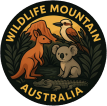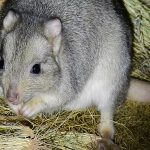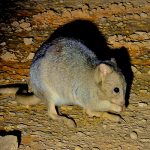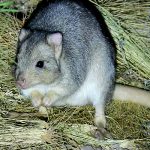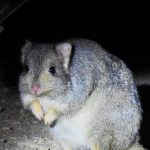LESUEUR'S RAT-KANGAROO
Australia’s Secretive Burrower
Hidden beneath the sandy soils of remote islands and select conservation reserves, lives a gentle architect of the Australian landscape: the Lesueur’s Rat-Kangaroo, also widely known as the Boodie or Burrowing Bettong. Once a common sight across the mainland, the Boodie now clings to survival in pockets of its former range, carrying forward a story of both challenge and enduring hope.
The Boodie’s Remaining Strongholds
Today, Boodies exist primarily on offshore islands such as Barrow, Bernier, Dorre, and Boodie Islands, and in carefully managed mainland conservation areas where reintroduction has met with success. These sites are marked by:
- Arid and semi-arid environments
- Loose, sandy soils—perfect for digging
- Sparse shrublands and open woodlands
These unique landscapes shape every aspect of the Boodie’s life.
A Nocturnal Forager and Ecological Engineer
As dusk falls and temperatures drop, the Boodie emerges. The crisp night air is quiet, punctuated by the soft sounds of paws shifting sand. The air carries a faint, earthy scent—a symphony of root, fungus, and dust.
Diet and Ecosystem Role
- Omnivorous: Roots, tubers, seeds, and especially underground fungi
- Critical for soil health: By feeding on fungal fruiting bodies, Boodies disperse fungal spores, enriching the soil and supporting plant life
Imagine putting your ear to the soft desert sand and hearing the delicate scrabble of digging as the Boodie searches for a fungal meal.
Burrow Life: Safe and Social
Boodies are master excavators. Using their powerful forelimbs, they create burrow systems that can stretch for many metres. These cool, dark tunnels offer:
- Safety from predators and harsh weather
- Shared living: Social groups often cohabit, exchanging warmth and protection
This communal nature sets the Boodie apart from many other marsupials, whose lives are often solitary.
The Cycle of Life
The Boodie’s life is both brief and prolific.
| Life Stage | Key Details |
|---|---|
| Gestation | ~21 days |
| Joey in Pouch | ~3 months |
| Weaned and Free | Few weeks after pouch emergence |
| Adult Lifespan | Typically 3–5 years in the wild |
Females can produce several young per year, and their adaptability has been vital for recovery efforts.
Conservation: Turning Challenge into Hope
The Boodie is listed as Vulnerable due to:
- Habitat loss
- Introduced predators (like foxes and cats)
Despite drastic declines, modern conservation offers hope:
- Reintroduction programs breathe new life into vanished populations
- Habitat restoration revives landscapes for future generations
- Predator control shields vulnerable colonies
Each successful program contributes to the Boodie’s story of survival.
A Deep Connection: Aboriginal Wisdom
To many Aboriginal Australians, the Boodie is more than just a species—it is a cultural and ecological pillar. Through tradition and story, Indigenous people recognise:
- The Boodie’s role in shaping land and soil
- Its value as a food source and in maintaining ecosystem balance
These traditions underscore a lesson: healthy landscapes depend on respect and understanding of all their living parts.
Conclusion: Cherishing the Unique
The tale of the Boodie is a tribute to resilience and the strength that comes from community—whether among the Boodies themselves or within those who strive to protect them. Through subtle cooperation, both human and animal lives can reshape the future of an entire ecosystem.
Let us take inspiration from the Boodie’s adaptability and the growing success of conservation to nurture and protect the unique wild heart of Australia. Every burrow dug and every spore dispersed is a small step towards a greater legacy—one where the Boodie, and the land it shapes, can thrive for generations to come.
Quick Facts at a Glance
| Feature | Details |
|---|---|
| Scientific Name | Bettongia lesueur |
| Status | Vulnerable |
| Lifespan | 3–5 years (wild) |
| Diet | Roots, tubers, seeds, fungi |
| Habitat | Sandy soils, arid/semi-arid regions |
| Social Structure | Colony-living, communal burrows |
| Conservation | Island refuges, mainland reintroductions, predator control |
Protecting the Boodie is protecting the living spirit of Australia’s wild places.
